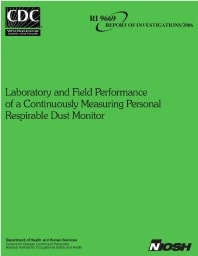Mining Publication: Laboratory and Field Performance of a Continuously Measuring Personal Respirable Dust Monitor
Original creation date: September 2006
Authors: JC Volkwein, RP Vinson, SJ Page, LJ McWilliams, GJ Joy, SE Mischler, DP Tuchman
NIOSHTIC2 Number: 20030902
Pittsburgh, PA: U.S. Department of Health and Human Services, Public Health Service, Centers for Disease Control and Prevention, National Institute for Occupational Safety and Health, DHHS (NIOSH) Publication No. 2006-145, Report of Investigations 9669, 2006 Sep; :1-55
The National Institute for Occupational Safety and Health (NIOSH), through an informal partnership with industry, labor, and the Mine Safety and Health Administration, has developed and tested a new type of instrument known as the personal dust monitor (PDM). The dust monitor is an integral part of the cap lamp that a miner normally carries to work and provides continuous information about the amount of respirable coal mine dust in the breathing zone of that individual. Testing was conducted on 25 prototype instruments in the laboratory to verify the instruments' accuracy as received from the manufacturer and after a period of underground use. The laboratory testing verified previous work; there is a 95% confidence that the individual PDM measurements were within ±25% of reference measurements. In-mine testing determined the precision, durability, and miner acceptance. Data from the mines showed a field precision of 0.078% relative standard deviation for the PDM and 0.052% for the recognized standard-the coal mine dust personal sampler unit. The PDM had about 90% availability for collecting valid information in over 8,000 hr of underground use. Anecdotal comments by miners indicated that they found the PDM more convenient to wear for sampling than currently used instruments because of the integration of the sampler into the normally worn cap lamp. The means of the instruments' pre- and postmine accuracy verification test values were statistically equivalent. Additional data were collected to measure the equivalency of the PDM to the U.K. Mining Research Establishment sampler, as required by U.S. law. However, analysis of the data was more complex than originally anticipated because the variance with increasing concentration required use of a more sophisticated statistical model. Explanation of and results from this work will be the subject of a second publication. Under the broad range of test conditions covered in this work, the PDM functioned as well as the current sampler in terms of availability for use, accuracy, precision, and miner acceptance.

NIOSHTIC2 Number: 20030902
Pittsburgh, PA: U.S. Department of Health and Human Services, Public Health Service, Centers for Disease Control and Prevention, National Institute for Occupational Safety and Health, DHHS (NIOSH) Publication No. 2006-145, Report of Investigations 9669, 2006 Sep; :1-55